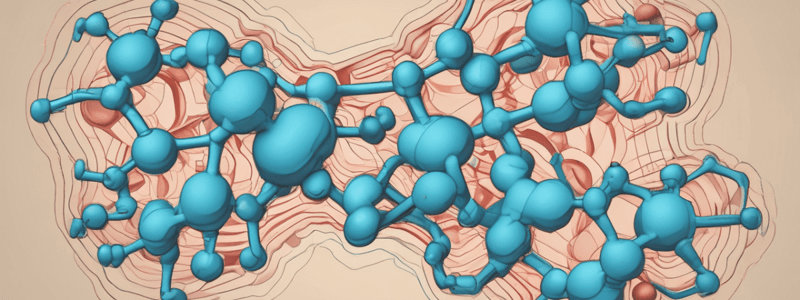Podcast
Questions and Answers
What type of amino acid is glutamic acid classified as?
What type of amino acid is glutamic acid classified as?
- Basic
- Aliphatic
- Acidic (correct)
- Neutral
What is the secondary structure formed by hydrogen bonds between amino acids held in a parallel or anti-parallel conformation?
What is the secondary structure formed by hydrogen bonds between amino acids held in a parallel or anti-parallel conformation?
- Tertiary structure
- Beta sheet (correct)
- Quaternary structure
- Alpha helix
What is the function of U-turns in protein structure?
What is the function of U-turns in protein structure?
- To form a disulfide bond
- To form a beta sheet structure
- To form a short loop of 3-4 amino acids (correct)
- To form a long loop of 10-15 amino acids
What type of bonds hold subunits together in quaternary protein structure?
What type of bonds hold subunits together in quaternary protein structure?
What is the effect of low hemoglobin levels?
What is the effect of low hemoglobin levels?
What specifies the special arrangements of the secondary structure?
What specifies the special arrangements of the secondary structure?
What type of mutation can lead to misfolding of proteins, as seen in Sickle cell disease?
What type of mutation can lead to misfolding of proteins, as seen in Sickle cell disease?
What is the characteristic secondary structure of the abnormal PrPC protein in Prions?
What is the characteristic secondary structure of the abnormal PrPC protein in Prions?
Which disease is associated with the accumulation of amyloid deposits?
Which disease is associated with the accumulation of amyloid deposits?
What is the term for proteins that have folded abnormally and aggregated together?
What is the term for proteins that have folded abnormally and aggregated together?
What is the normal function of the PrPC protein?
What is the normal function of the PrPC protein?
What is the result of abnormal PrPC converting normal PrPC into an abnormal form?
What is the result of abnormal PrPC converting normal PrPC into an abnormal form?
How many different proteins can form amyloid deposits?
How many different proteins can form amyloid deposits?
What is the typical secondary structure of the normal PrPC protein?
What is the typical secondary structure of the normal PrPC protein?
Which amino acid is always found at the N-terminus of a polypeptide chain?
Which amino acid is always found at the N-terminus of a polypeptide chain?
Which of the following amino acids contains a free sulfhydryl group that can form disulfide bonds?
Which of the following amino acids contains a free sulfhydryl group that can form disulfide bonds?
What is the primary structure of a protein?
What is the primary structure of a protein?
Which of these groups does the amino acid tyrosine belong to?
Which of these groups does the amino acid tyrosine belong to?
Why are the peptide bonds that link amino acids together in a polypeptide chain unable to rotate freely?
Why are the peptide bonds that link amino acids together in a polypeptide chain unable to rotate freely?
Which statement about the stereoisomers of α-amino acids is TRUE?
Which statement about the stereoisomers of α-amino acids is TRUE?
Flashcards are hidden until you start studying
Study Notes
Protein Structure
- Hydrogen bonds hold the beta-sheet structure in the correct conformation
- Beta-sheet structure is parallel or anti-parallel
Beta Turns
- Formed by 3-4 amino acids, commonly glycine and proline
- Create a short loop
Tertiary Structure
- Specifies the special arrangements of the secondary structure
- Acidic amino acid: glutamic acid
- Basic amino acid: lysine
Quaternary Protein Structure
- Consists of several subunits held together by non-covalent bonds
- Example: Haemoglobin
Haemoglobin
- Abnormal levels can indicate anemia (reduced level of red blood cells)
Amino Acids
- α-amino acids contain an asymmetric carbon
- 2 stereoisomers exist (enantiomers/optical isomers)
- Proteins in all life only contain L-amino acid enantiomers
- The surface of proteins is asymmetric, allowing for highly specific molecular recognition
Groups of Amino Acids
- Non-polar and hydrophobic
- Aromatic (phenylalanine and tryptophan are non-polar and hydrophobic; tyrosine is polar and hydrophobic)
- Polar, hydrophilic, and acidic
- Polar, hydrophilic, and basic
- Hydroxylic, sulphur-containing, and amidic
Methionine and Cysteine
- Both contain sulphur
- Methionine is always the first amino acid in a polypeptide chain
- The free sulphydryl group of cysteine is highly reactive and often used in enzyme active sites
- Cysteine can form disulfide bonds
Primary Protein Structure
- The linear sequence of amino acid residues from the N- to the C-terminus
- Formed through peptide bonds between amino acids
- Peptide bonds cannot rotate freely
Abnormal Protein Structure
- Can affect protein function
- Examples: sickle cell disease (point mutation leading to misfolding), cystic fibrosis (point mutation leading to trapping of protein in the ER), and Duchene muscular dystrophy (point mutation leading to premature stop codons)
Abnormal Secondary Structure
- Can affect protein function
- Example: Amyloidosis (abnormal folding and aggregation of proteins, forming extracellular deposits)
- Prions (proteinaceous infectious particles, no DNA/RNA)
- Prion protein (PrPC) abnormal form can convert normal PrPC into abnormal form in a chain reaction
Studying That Suits You
Use AI to generate personalized quizzes and flashcards to suit your learning preferences.



